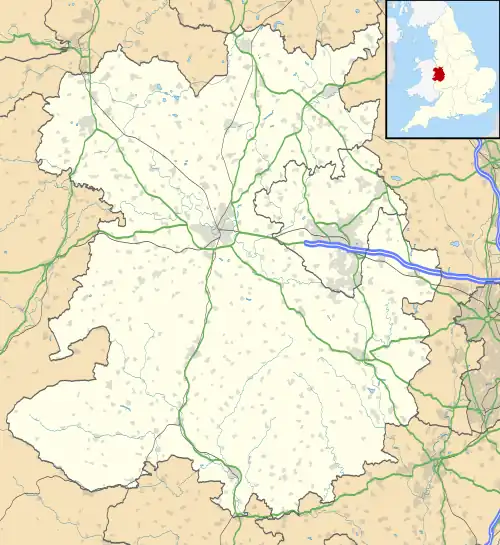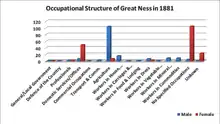Great Ness
Great Ness and Little Ness are civil parishes in Shropshire, England.
| Great Ness | |
|---|---|
 Adcote School for Girls | |
 Great Ness Location within Shropshire | |
| OS grid reference | SJ398188 |
| Civil parish |
|
| Unitary authority | |
| Ceremonial county | |
| Region | |
| Country | England |
| Sovereign state | United Kingdom |
| Post town | SHREWSBURY |
| Postcode district | SY4 |
| Dialling code | 01743 |
| Police | West Mercia |
| Fire | Shropshire |
| Ambulance | West Midlands |
| UK Parliament | |
Common local governance
The two parishes share a parish council. The parishes cover the area surrounding the village of Nesscliffe, Hopton, Kinton, Willcot, Felton Butler and Alderton. They are represented on the unitary Shropshire Council, and in the Shrewsbury and Atcham Parliamentary constituency. The Great Ness and Little Ness Parish council meet on the first Tuesday of every month, except for January and August, at Nesscliffe Village Hall or Little Ness Village Hall.[1]
Great Ness - the hamlet
Great Ness is compact and consists of various styles of dwellings, many of which have become Listed Buildings. In total there are 25 Listed Buildings in the parish of Great Ness with a Grade II listing or higher.[2]
The Church of Saint Andrew, the Church of England parish church in Great Ness is protected by Grade I listing. It was mentioned in the Domesday Book as the "Manor of Nessham" due to it being one of the seven churches Roger de Montgomery, the first Norman Earl of Shrewsbury, retained in his own hands.[3] The church is part of a benefice also including Little Ness and Ruyton-XI-Towns. Topographer Samuel Garbet was curate at Great Ness before becoming a school master at Wem in 1712.[4]
In 2011 Great Ness became a conservation area.[5]
History
Throughout time Great Ness has had a few changes in registration districts. In 1935 the Ellesmere district lost Great Ness to the Oswestry district and just over 30 years later, in 1967, Shrewsbury gained Great Ness and became its registration district.[6] Coincidentally the only major boundary change that took place was in 1967 when it was reduced to aid the enlargement of another parish, Kinnerley.[7]
Population

Between 1881 and 2001 Shropshire has experienced a rapid population increase of 10.5% which is over twice as fast as the growth of England which is 4.8%. However the increase has not been due to natural growth but the migration of people into the area. Migration to the Shropshire area in 2001 was high with 13,613 migrants moving into the Shropshire area, North Shropshire showed the highest overall level of net inward migration. This most likely to be explained by the inward migration of 933 people into communal establishments in the area, the RAF Shawbury, the Tern Hill Barracks or HM Youth Custody Centre.[9]
The population of Great Ness has generally followed trend and risen in population since the early 19th century, but did experience a few decades of decline from 1881 to 1931 where the population fell by 200 in the space of 50 years. However, in contrast to this Great Ness experienced rapid growth from 1931 to 1951 reaching an all-time high of 1536. The most recent count of Great Ness's population is from the 2001 census showing Great Ness to have a population of 807,[10] increasing to 879 at the 2011 Census.[11]
In general the early census reports were very simplified creating confusion with things such as the classifications of occupation, leading to issues like social status and what the individual workers did being mixed up. In the census report of 1881 more organised classifications were implicated covering over 414 categories.[12] The graph below is made from the 1881 census report showing agriculture to be the most dominant occupation, accounting for over 50% of all males. Whereas the majority of women were found to be working in domestic services or offices.
Due to Great Ness lying to the north of the River Severn it receives fertile deposits which is how it resulted in settlement and agriculture. The river valley's crops indicate agricultural activity as far back as the Bronze Age.[13] The majority of the area remains largely rural in character and sparsely populated.

Attractions
Humphrey Kynaston commonly known as 'Wild Humphrey Kynaston', son of Sir Roger Kynaston a former High Sheriff of Shropshire, got his nickname from his lifestyle and frequently getting into trouble with the law. Consequently, his legendary deeds have become the basis for many attractions in the local area including Nesscliffe Country Park and Nesscliffe Rock Cave.
Nesscliffe Country Park
Nesscliffe Country park lies just off the A5 between Oswestry and Shrewsbury.
The Old Three Pigeons Inn, dated back to the 15th century, is located south of the entrance to the Park and was said to be the watering hole of Humphrey Kynaston. Inside, the seat from Kynaston's cave is now part of the Inn's fireplace.
The park itself is divided into three areas, from south to north: Nesscliffe Hill, Hopton Hill and The Cliffe (the latter a common land hill whose northern access footpaths begin at Ruyton-XI-Towns). Shruggs Common, believed to be the smallest common in Shropshire of approximately 1/4 acre, is found on Nesscliffe Hill.[15]
Nesscliffe Rock Cave
The Nesscliffe Rock Cave is part of the Nesscliffe Country Park. It is a small sandstone cave and is better known as Kynaston's Cave as it is the place he and his steed Beelzebub sought refuge. The entrance to the cave is six metres high and stairs were cut into the soft rock, however over time the stairs have eroded.[16] Inside the cave can be seen two chambers approximately four square metres big and the date 1564 carved into one of the walls, followed by the initials of H.K., reputedly of Humphrey Kynaston.[17] A wooden staircase once existed to give access to the cave but was not extant as of 2015; today the steps have been fenced off and the mouth and window of the cave shut off by grids.[18]
Little Ness
Little Ness has its own civil parish, the population of which as taken at the 2011 census was 303.[19]
Little Ness has its own Church of England parish church, St Martin's, built on a mound. It was built in the 12th century as a chapel to Baschurch. It consists of a nave and chancel within one roof, with a bellcote at the west end, was remodelled in the 15th century and restored in Perpendicular style in 1877-78, with a north porch and vestry added. The circular font is Norman, as is the south doorway and there are some patterned mediaeval tiles in the chancel, which has a wide-shuttered reredos of 1878, said to have been perhaps designed by Norman Shaw when he was working at Adcote,[20] and a rood added in 1927. There are mediaeval stained glass fragments including a head of Christ in the vestry, a window depicting the Adoration of Christ Crucified (1905) by Kempe, the east window, depicting Christ in majesty, erected in 1910,[21] and war memorial windows to two men killed in World War I, Leonard Arthur (killed 1914), and Lieutenant Maurice Darby (killed at Battle of Neuve Chapelle 1915). The latter is buried in the churchyard,[22] one of few Englishmen killed at the Western Front whose bodies were repatriated.[23] The churchyard has the hexagonal steps and moulded base of a mediaeval cross.[21]
Within the village, at a T-junction, is an outdoor First World War parish war memorial in the form of a Portland stone crucifix on a Grinshill stone plinth.[24] It lists nine men who died, including Maurice Darby, 20 who 'fought' and 8 who were 'engaged' (i.e. did not fight).
Little Ness is the location of the independent girls' day and boarding school Adcote, within a late Victorian country house built by Richard Norman Shaw for the Darby family. The school was founded in 1907 and came to Little Ness in 1927 where it has grown significantly converting out houses and stables into classrooms. In 2014, the school announced plans to expand its boarding accommodation by over 100 beds and to develop new facilities on site, due to overseas investment that the school had received. When the school first came to Adcote it was filled to capacity of 72 boarders, it currently has 280 pupils, 120 of them being boarders. Adcote celebrated its centenary in 2007.[25]
Conservative politician Derek Conway, while M.P. for Shrewsbury, lived at Little Ness in 1988.[26]
References
- "Great Ness and Little Ness Parish Council" Retrieved on 30 March 2012
- "Listed Buildings in Great Ness" British Listed Buildings. Retrieved 26 April 2012.
- Owen, Hugh. "A History of Shrewsbury, Volume 2" Retrieved 25 April 2012
- Dictionary of National Biography (1889), Volume 20, pp.403-404, publisher Smith, Elder & Co.
- BBC News New Shropshire conservation area designated (17 November 2011)
- "Registration Districts" GENUKI. Retrieved 20 April 2012
- "Boundary Changes" Vision of Britain. Retrieved 28 April 2012
- "Population Statistics" Vision of Britain. Retrieved 2 May 2012
- "Migration"Shropshire Council. Retrieved 1 May 2012
- "Parish Headcounts" Neighbourhood Statistics. Retrieved 28 April 2012
- "Civil Parish population 2011". Retrieved 26 November 2015.
- "Historical Statistics" Vision of Britain. Retrieved 1 May 2012
- "The Physical Environment"British History Online. Retrieved 26 April 2012
- "Population Statistics" Vision of Britain. Retrieved 30 April 2012
- "Nesscliffe Country park" Archived 17 February 2012 at the Wayback Machine Virtual Shropshire. Retrieved 20 April 2012
- "Humphrey Kynaston's Cave" Archived 4 February 2012 at the Wayback MachineShowcaves. Retrieved 1 May 2012
- "Great Ness" GENUKI. Retrieved 26 April 2012
- As discovered by user on 1 January 2015.
- "Little Ness Ciuvil Parish population 2011". Retrieved 26 November 2015.
- The possibility of it being Shaw's work is stated with a question mark in the description of the church in The Buildings of England, Shropshire (2006).
- Newman & Pevsner, John & Nikolaus (2006). The Buildings of England, Shropshire. Yale University Press. p. 334. ISBN 0-300-12083-4.
- CWGC Casualty Record, Maurice Darby.
- Francis, Peter (2013). Shropshire War Memorials, Sites of Remembrance. YouCaxton Publications. pp. 174–175. ISBN 978-1-909644-11-3.
- Shropshire War Memorials, Sites of Remembrance. p. 175.
- "History" Archived 25 May 2012 at the Wayback Machine Adcote School for Girls. Retrieved 28 April 2012
- Shropshire County Guide. British Publishing Company, Gloucester. 1988. p. 121. ISBN 0-903802-40-6.